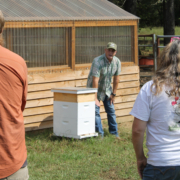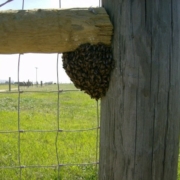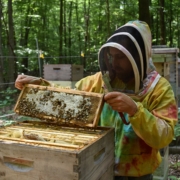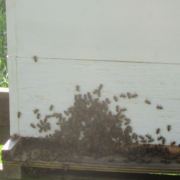Free Bees, Part One: Finding Them
 Print This Post
Print This Post
By Justin Duncan, NCAT Agriculture Specialist
As a beekeeper, I get blamed for all the bees taking up residence in folks’ houses in the area. Its not fair because I properly maintain my bees and thus prevent swarming. I happily remove these bees, of course, to grow my collection, so their misplaced blame leads to proper placement of bees for me.
I recently had to remove a newly settled swarm from a house, which was an interesting challenge. The homeowner asked me to come solve her bee problem and it took me a few days to figure it out. I saw the entry point, a space behind the soffit. Folks! Please go check your eaves and underhangs right NOW! If there are any gaps about the size of a dime, or larger, caulk them up. If, however, that gap has bees flying in and out of it, call me. Okay, I’m kidding, but do call your friendly neighborhood beekeeper. After finding the entry point, I used my FLIR and didn’t see any heat signature… odd. I then removed a section of soffit and to my chagrin, no bees. Frustrated, I removed a section of soffit on the other side. NO BEES! I began to feel like the late Bogdanoff twins were telling the bees to move.
After getting all of my equipment ready and laid out all organized for what I thought was going to be an easy removal, I put it all up and just observed the bees. Nothing’s easy, it’s never easy. They were coming and going, a clear indication that something bee-related was going on. However, they were not bringing in pollen. I asked the homeowner if she had spilled anything sweet, wondering if maybe they were foraging for something. She had not. Observation continued, still no pollen, still no heat signature on the FLIR. I removed some crown molding and observation continued. Their ingress/egress point shifted 6 feet, and my observation continued.
After two failures to find the bees by removing a section of soffit, I was ready to try again. I saw them starting to bring in pollen; there were bees crowded at the new entry point and there was a slight color gradiant on the FLIR camera. Confidence restored because I saw all the usual signals that a hive was at home here. I removed a section of soffit and bingo! Eureka! Finally found a nice-sized swarm. They had been there only a couple days and built a tiny amount of comb, but they were ambitiously latticed to lay much more.
I used a broken-off chunk of soffit to scrape the bees off into a nuc I balanced underneath them, and in a few sweeps, they were mostly in the box. I vacuumed up the rest and voila! Bees. Rehomed. Mostly. After spending the night in their new spot, I dumped the bees in the vacuum in with the rest and untaped the nuc entrance. Now they are doing their thing in a place they are wanted and not scaring nice ladies as they are doing their thing.
This is swarm season, and many panicked homeowners will find bees where there weren’t any before and, unfortunately, many will call exterminators to kill them rather than beekeepers who can safely remove them (no homeowners or Justins were stung during this process). Swarms are out there, hopefully not due to irresponsible beekeepers, but just Nature doing her thing.
Are these bees truly free? There are, of course, costs in time, effort, energy, equipment, and materials. Experience really plays a role, too. Had I been impatient, I could have closed it all up after the first two failures but experience told me there was more to the story.
Related ATTRA Resources:
Beekeeping: Overwintering Bees in Warm Places
Episode 214. Attracting and Protecting Pollinators
Alternative Pollinators: Native Bees
This blog is produced by the National Center for Appropriate Technology through the ATTRA Sustainable Agriculture program, under a cooperative agreement with USDA Rural Development. ATTRA.NCAT.ORG.

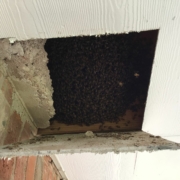
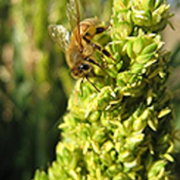
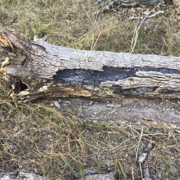
 USDA photo by Lance Cheung
USDA photo by Lance Cheung